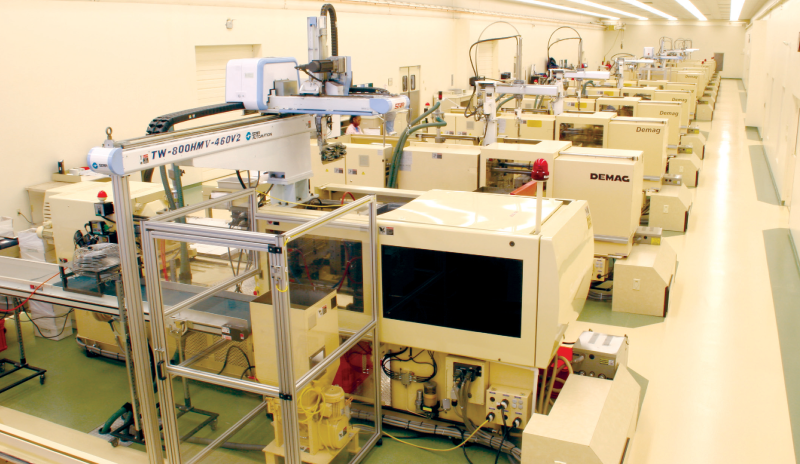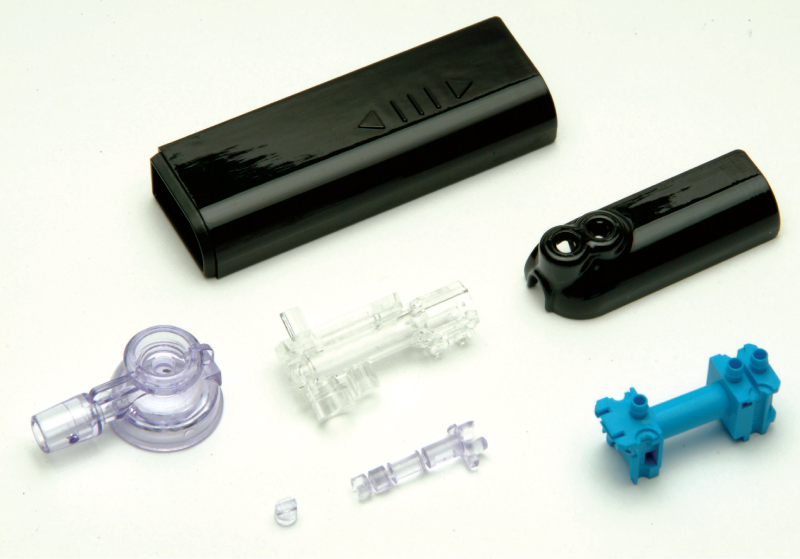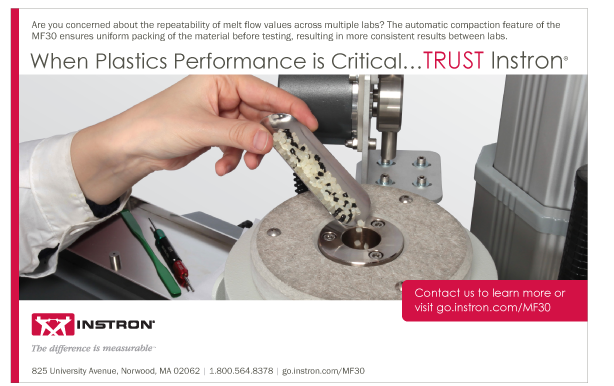Less is More in Sustainable Molding
Award-winning molder Plastikos has found that “reduce” is the key term from the “3 R’s” of sustainability
Previous Article Next Article
By Michael Tolinski
Less is More in Sustainable Molding
Award-winning molder Plastikos has found that “reduce” is the key term from the “3 R’s” of sustainability
Previous Article Next Article
By Michael Tolinski
Less is More in Sustainable Molding
Award-winning molder Plastikos has found that “reduce” is the key term from the “3 R’s” of sustainability
Previous Article Next Article
By Michael Tolinski

The main “whiteroom” molding floor of Plastikos

The main “whiteroom” molding floor of Plastikos

A sampling of plastic medical components molded by the company

A sampling of plastic medical components molded by the company

A Plastikos engineering team meets to discuss an internal tooling continuous improvement project, like sprue and runner reduction

A Plastikos engineering team meets to discuss an internal tooling continuous improvement project, like sprue and runner reduction
In efficient plastics processing, the recycling and reuse of regrind and scrap have become common practices, with the third term of the “3 R’s” of sustainability—reduce—sometimes not getting deserved emphasis. This is not the case at Plastikos, Inc., a medical and electronics molder in Erie, Pennsylvania, USA. Not only has the company received recognition from Plastics News recently as “Processor of the Year” (2011) and “Best Place to Work” (2014), its green efforts have led to it earning one of Frost & Sullivan’s 2013 Manufacturing Leadership 100 Awards.
Plastics Engineering decided to learn first-hand about the molder’s sustainability efforts (visiting Plastikos, coincidentally, on Earth Day—April 22). We spoke with Philip Katen (Plastikos president and general manager), Ryan Katen (general manager of Plastikos’s sister company Micro Mold Co., Inc., and leader of the molder’s sustainability efforts), and Rob Cooney (Plastikos manufacturing manager).
Low-Hanging (Green) Fruit
You might think that molding sustainably begins with the molding process. But Ryan Katen says the “low-hanging fruit” for saving energy is literally overhead: in the lighting. Making a switch to high-efficiency lighting was “an easy change that you can get recurring savings from,” he says, thus it’s a good sustainability initiative to start with.
Changing the lighting in the company’s molding shop offered the biggest returns for the least investment, where high-efficiency T8 fluorescents create an extremely well-lit working space. “T8 was the best choice for us at the time we did this project; however, there are better lighting choices today for even more efficient lighting,” notes Katen.
However, finding sustainability initiatives for reducing energy and materials in the molding process was a bit tougher. Obviously, optimizing the use and value of regrind is “green” both in terms of money and waste-avoidance, but it’s somewhat challenging for the company’s part portfolio. Connectors for electronics produce a lot of runner system scrap relative to the size of the part (the largest of which is only about six inches (150 mm) long). But at least some of the connectors can be made with 25-50% regrind, unlike Plastikos’s medical parts, in which 0% regrind is allowed.
Thus the goal was to find external buyers for the high-value scrap, even with the company’s relatively low quantities. “We have a lot of small-volume, unique materials that we run, because we’re a custom molder,” says Ryan Katen. All this variety makes it difficult for Plastikos to sell material to recyclers at the volumes they prefer. Low-volume buyers were not easy to find.
The company had to embark on a “deep search” for recycling partners. “There’s a bunch [of recyclers] out there; you just have to look hard for them,” Katen says. Perseverance paid off, and selling regrind has become the company’s biggest green-related process cost savings. “We even found someone who buys the purgings,” he adds.
The company is also reclaiming many of its difficult-to-reuse materials, says Rob Cooney—“especially glass-filled regrind, which typically has significant variation in pellet size (in relation to the consistency of virgin pellets), even [when using] the best of granulators.” Cooney says the company found a way to reuse small regrind fines rather than discard the material.
Reduce (…then Reuse and Recycle)
Nonetheless, despite some success in finding recycler-buyers of its scrap, it’s really the reduction of scrap and regrind that the company is targeting to reduce waste and landfill costs. One approach is to reduce the size of sprues and runners, since they are disproportionately large in small-part molding. Hot runners are another savings approach; however, most of the custom molder’s part volumes do not justify the cost of hot-runner manifolds.
Cooney explains: “If you’re molding really small parts like we do, the runner uses a greater volume of material than the part does”; therefore, reducing the runner size is more critical than simply reusing/recycling that scrap material.
Reducing runner and sprue sizes means there’s less regrind to recycle or deal with. However, there’s another benefit: Smaller runner systems typically allow reduced cycle times. “But one needs to also be mindful of reduced barrel utilization and potential negative implications for shot-to-shot consistency, material degradation, etc.,” adds Cooney.
“Reduce” efforts are supported in other, non-obvious ways—for example, by making internal scrap very visible. They’re supported by plant-wide improvement projects, like the company’s enterprise resource planning (ERP) system from IQMS, implemented since 2001 and cited as the reason the company won a second “Manufacturing 100” award. “Combining [ERP] with automated separation of suspect parts at the machine level helps to better focus employees on value-added activities and effective implementation of continuous improvement projects,” Cooney explains.
All of these efforts have paid off, says company president Philip Katen: The amount of overall waste Plastikos has sent to landfill has been reduced by at least 75%.
Other Sustainable Initiatives
The company has implemented other green initiatives—from installing a central compressed-air system for drying resins, to laundering used rags in-house for re-use (even though that doesn’t save a lot of money, admits Ryan Katen, it’s still the right thing to do).
Paper waste is being cut out too. For example, the company’s toolmakers used to use large sheets of paper prints for specifying mold rework, but now the changes are displayed only electronically, via monitors on the toolmakers’ benches.
Meanwhile, a long-term changeover of molding machine types will help save energy, Ryan Katen adds. “We’re in the process of upgrading to all-electric presses.” The main Plastikos molding shop now only has three hydraulic presses left (soon to be just one hydraulic press) out of sixteen total, which range in press tonnage from 66 tons up to 220-ton machines with pick-and-place robots.
The energy-loss differences between the two press types can be obvious. For example, Philip Katen states that when all of Plastikos’s presses were hydraulic, the company never had to turn the heat on in the winter on the production floor, and sometimes even had to run the air conditioning. “But [since the installation of all-electrics], we now need to actually turn on the heat from time to time during the winter.” Still, he says that the energy efficiency of the all-electrics has not been the primary driver for their purchase. Rather it’s their capabilities such as higher repeatability and process quality and faster cycling, though the energy savings are a great added bonus to Plastikos’s bottom-line, he adds.
Next Steps
The company’s future will be shaded green. “We’re looking at various expansion plans, and trying to proactively incorporate green design and sustainability considerations into that next phase,” says Philip Katen. This includes green building techniques. He emphasizes that it’s better to plan sustainability “proactively” rather than rely simply on implementing the “three R’s” of reduce, reuse, and recycle in a current operation.
